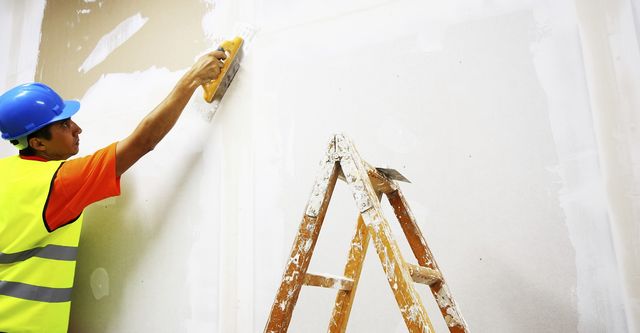Drywall Setup Made Easy: Tips for Perfect Results
Drywall installation is commonly regarded as an overwhelming job, yet with the appropriate approach and understanding, it can become a workable undertaking. Mastering techniques for reducing, hanging, and completing drywall can substantially affect the result.
Selecting the Right Products
Picking the appropriate products for drywall setup is critical to achieving a long lasting and cosmetically pleasing surface. drywall contractor. The primary component, drywall sheets, usually can be found in numerous thicknesses, with 1/2-inch sheets being typical for indoor walls. For locations needing added moisture resistance, such as shower rooms or kitchens, consider making use of green board or cement board, which are specially created to hold up against humidity

Furthermore, selecting the appropriate bolts-- either nails or screws-- is crucial for safeguarding the drywall to the framing. Drywall screws are generally favored for their holding power and lowered risk of standing out. Finally, consider the complements such as primer and paint, which not only enhance the look however additionally secure the drywall from wetness and wear.
Preparing the Installment Location
Before starting the drywall installment process, it is important to prepare the setup location thoroughly. A clean work area minimizes the risk of damage to existing products and enables for effective movement during installment.
Next, examine the walls and ceiling for any kind of imperfections, such as fractures, holes, or mold and mildew. Address these concerns ahead of time; patch any type of problems and enable sufficient time for fixings to completely dry. Additionally, ensure that electric outlets, switches, and plumbing are appropriately placed and accounted for, as this will impact drywall positioning.
Consider the environmental problems. A secure temperature level and moisture level are important for optimal bond and performance of the drywall products. If necessary, make use of a dehumidifier or heating unit to produce appropriate conditions.
Cutting and Hanging Drywall
The key to reliable drywall installation lies in the specific cutting and hanging of the panels. Utilize a straight side and an utility blade to rack up the drywall along your measurements, then break it along the scored line for a clean break.

Always work from the top down and left to right, making certain that you keep a staggered pattern to improve security. Effectively hanging the drywall establishes the structure for a smooth finish, eventually leading to premium lead to your drywall project.
Taping and Mudding Methods
While correct cutting and dangling of drywall establishes the stage, the next essential action entails mastering taping and mudding techniques to ensure a smooth surface. Insulation is essential for enhancing joints and stopping cracks; it entails embedding tape right into the applied joint substance (mud) Begin with a quality fiberglass or paper tape, using the tape over the joint and pushing it into the wet mud using a taping blade, making certain no air bubbles remain.
As soon as the tape is in location, use a slim layer of joint substance over the tape, feathering the sides to develop directory a smooth transition to the drywall surface area. Allow this layer to completely dry totally before sanding it lightly to eliminate blemishes. Repeat this procedure, using additional layers of mud as needed-- commonly 2 to three coats-- while slowly expanding the application area with each layer to accomplish a smooth look.
After the final layer dries, sand the surface with a fine-grit sandpaper up until smooth. drywall repair. Bear in mind to put on a mask throughout sanding to avoid breathing in dirt bits. Understanding these taping you could try this out and mudding strategies is vital for attaining a professional-quality coating in your drywall installation
Ending Up Touches for Perfection
Attaining a perfect drywall installment goes beyond mudding and taping; it finishes in the completing touches that raise the overall appearance. These final actions are important in ensuring a professional-grade finish that improves the aesthetics of your room.
Begin by sanding the dried out joint compound to produce a smooth surface area. sheetrock repair fort worth. After fining sand, wipe down the wall surfaces with a moist cloth to remove any type of dirt bits, making certain a clean surface for painting.
Next, apply a primer specifically made for drywall. This step is crucial, as it helps seal the joint substance and offers a consistent base for the overcoat. When the guide dries, check for any type of imperfections, and retouch as required.
Conclusion
In conclusion, successful drywall setup hinges on the cautious choice of materials, detailed prep work of the setup location, and precise execution of reducing and hanging techniques. Proficiency of taping and mudding processes is crucial for achieving a smooth surface.
Drywall setup is commonly regarded as a difficult task, yet with the best technique and expertise, it can come to be a manageable venture.Choosing the ideal products for drywall setup is important to attaining a long lasting and aesthetically pleasing surface.Prior to starting the drywall setup process, it is necessary to prepare the installation area extensively. Understanding these taping and mudding methods is essential for accomplishing a professional-quality surface in your drywall installation.
In conclusion, effective drywall setup hinges on the careful selection of products, complete prep work of the setup location, and accurate implementation of reducing and hanging techniques.